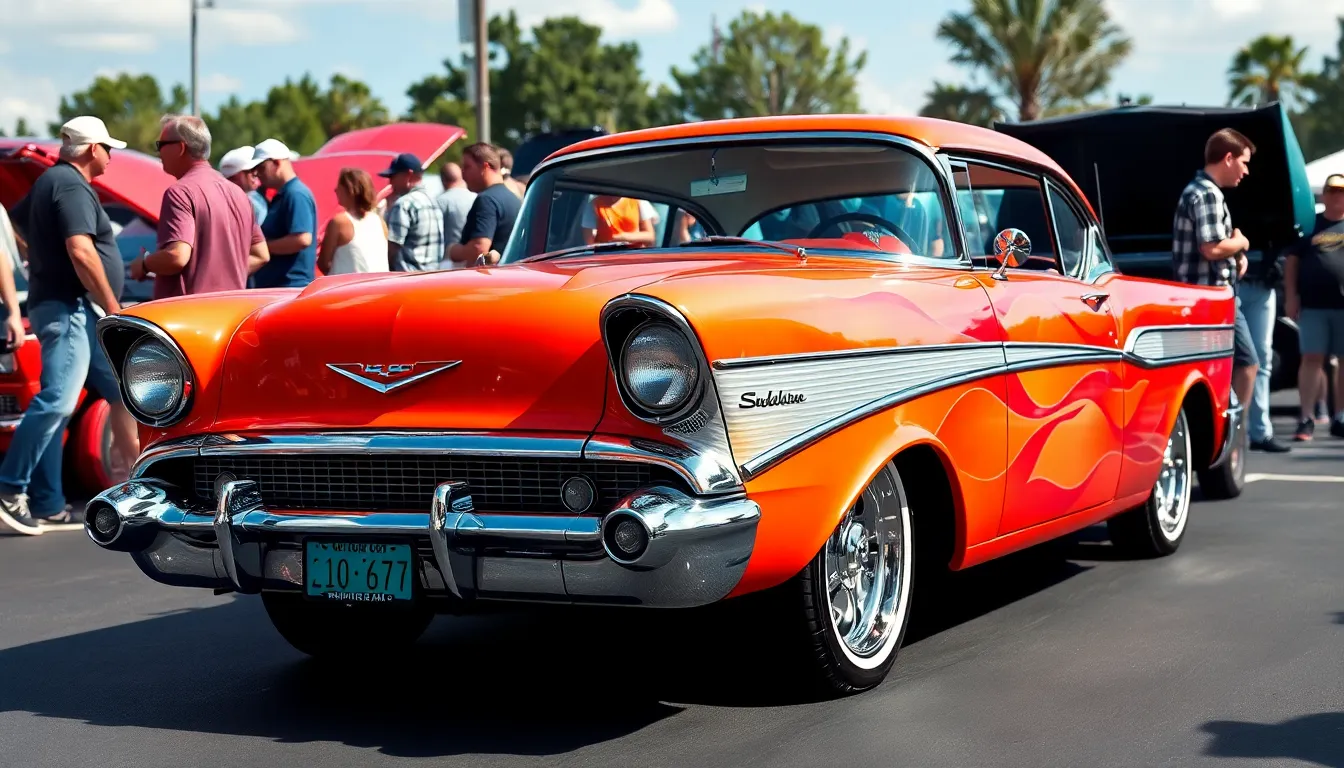Rockabilly cars represent more than just vintage automobiles – they’re rolling pieces of American rebellion that capture the raw energy of the 1950s music scene. These chrome-laden beauties emerged alongside the birth of rock ‘n’ roll, when hot rodders and greasers transformed classic cars into expressions of youthful defiance and style.
We’ve all seen them cruising down main streets with their lowered suspensions, flames dancing across custom paint jobs, and chrome accents gleaming under streetlights. From chopped Mercury coupes to flame-painted Ford hot rods, these machines embody the perfect marriage between automotive craftsmanship and rockabilly culture.
Today’s rockabilly car scene thrives as enthusiasts preserve this iconic slice of Americana. Whether you’re drawn to the thunderous rumble of a flathead V8 or the sleek curves of a ’49 Mercury, understanding these automotive time capsules opens a window into a defining era of American cool.
Classic Hot Rods That Define Rockabilly Culture
These legendary automobiles represent the heart of rockabilly car culture, each bringing unique styling elements that captured the rebellious spirit of the era.
1932 Ford Roadster
Ford’s iconic 1932 Roadster stands as the ultimate rockabilly hot rod, embodying everything enthusiasts love about classic American automotive design. We see this legendary vehicle featured in countless rockabilly gatherings, its chopped windshield and exposed chrome headers creating an unmistakable silhouette. Custom paint jobs in vibrant reds, deep blues, and classic black dominate these builds, while flame graphics add that essential rebellious flair.
Engine modifications transform these roadsters into powerful street machines, with many owners installing small block V8s that deliver thunderous exhaust notes. Wide rear tires and narrow fronts give the car its signature stance, while suicide doors and custom upholstery complete the authentic rockabilly aesthetic. Chrome detailing on bumpers, grilles, and trim pieces reflects the era’s obsession with polished metal accents.
1940 Ford Coupe
This sleek coupe represents the perfect balance between elegance and attitude that defines rockabilly car culture. We observe how the 1940 Ford’s naturally flowing lines require minimal modification to achieve that coveted hot rod appearance. Lowered suspensions drop these cars closer to the ground, creating the aggressive stance that rockabilly enthusiasts crave.
Popular modifications include chopped tops that reduce windshield height by several inches, giving the coupe a more streamlined profile. Custom wheels, often in steel with chrome trim rings, maintain the period correct appearance while white wall tires add classic styling touches. Interior treatments feature rolled and pleated upholstery in bold colors like red, blue, or traditional black vinyl.
1957 Chevrolet Bel Air
Chevrolet’s 1957 Bel Air captures the peak of 1950s automotive styling with its distinctive chrome details and iconic tailfins. We recognize this model as a rockabilly favorite due to its perfect timing, representing the height of the era’s musical and cultural movement. Two tone paint schemes in combinations like red and white or blue and cream showcase the car’s sculptural body lines.
Performance upgrades center around Chevrolet’s legendary small block V8 engine, which delivers both power and that distinctive American muscle car sound. Lowered rear ends and custom exhaust systems create the rumbling soundtrack that complements rockabilly music perfectly. Chrome bumpers, detailed grilles, and polished trim pieces maintain the factory’s attention to decorative elements while custom interiors feature period appropriate materials and colors.
Muscle Cars With Rockabilly Attitude

While classic hot rods laid the foundation for rockabilly car culture, the late 1960s muscle car era brought raw power and aggressive styling that perfectly captured the rebellious spirit of rock and roll.
1969 Dodge Charger R/T
This legendary muscle car dominates the scene with its intimidating presence and thunderous performance capabilities. Dodge engineers equipped the Charger R/T with the legendary 440 Magnum V8 engine, producing 375 horsepower that could propel this beast from 0 to 60 mph in just 5.1 seconds. Custom modifications often include lowered suspensions, wider rear tires, and distinctive racing stripes that enhance its menacing appearance. Chrome exhaust tips and aggressive hood scoops give the Charger an unmistakable rockabilly edge. Many enthusiasts paint their Chargers in bold colors like Plum Crazy Purple or Go Mango Orange to match the vibrant energy of rockabilly music.
1970 Plymouth ‘Cuda
Plymouth’s most ferocious muscle car embodies pure rockabilly rebellion with its shark-like design and earth-shaking power. Factory options included the legendary 440 Six Pack and the brutal 426 Hemi V8, delivering up to 425 horsepower of raw American muscle. Distinctive features like the aggressive front grille, bold side graphics, and dramatic rear spoiler create an unmistakable profile that screams attitude. Custom rockabilly modifications often feature flame paint jobs, whitewalls, and chrome accessories that blend vintage styling with modern performance. Exhaust systems with deep, rumbling tones perfectly complement the car’s fierce appearance and rebellious character.
1968 Chevrolet Camaro SS
Chevrolet’s answer to the pony car wars perfectly captures rockabilly style with its sleek lines and powerful performance options. Standard SS models came equipped with the 396 cubic inch big block V8, generating 325 horsepower that delivered impressive acceleration and quarter mile times. Racing stripes, hood scoops, and distinctive SS badges create a visual impact that matches the car’s performance capabilities. Popular rockabilly modifications include lowered stances, wide rear tires, and custom paint schemes in classic colors like Rally Green or Butternut Yellow. Chrome exhaust tips and dual exhaust systems provide the soundtrack that complements this muscle car’s rebellious personality.
Custom Paint Jobs That Scream Rockabilly Style
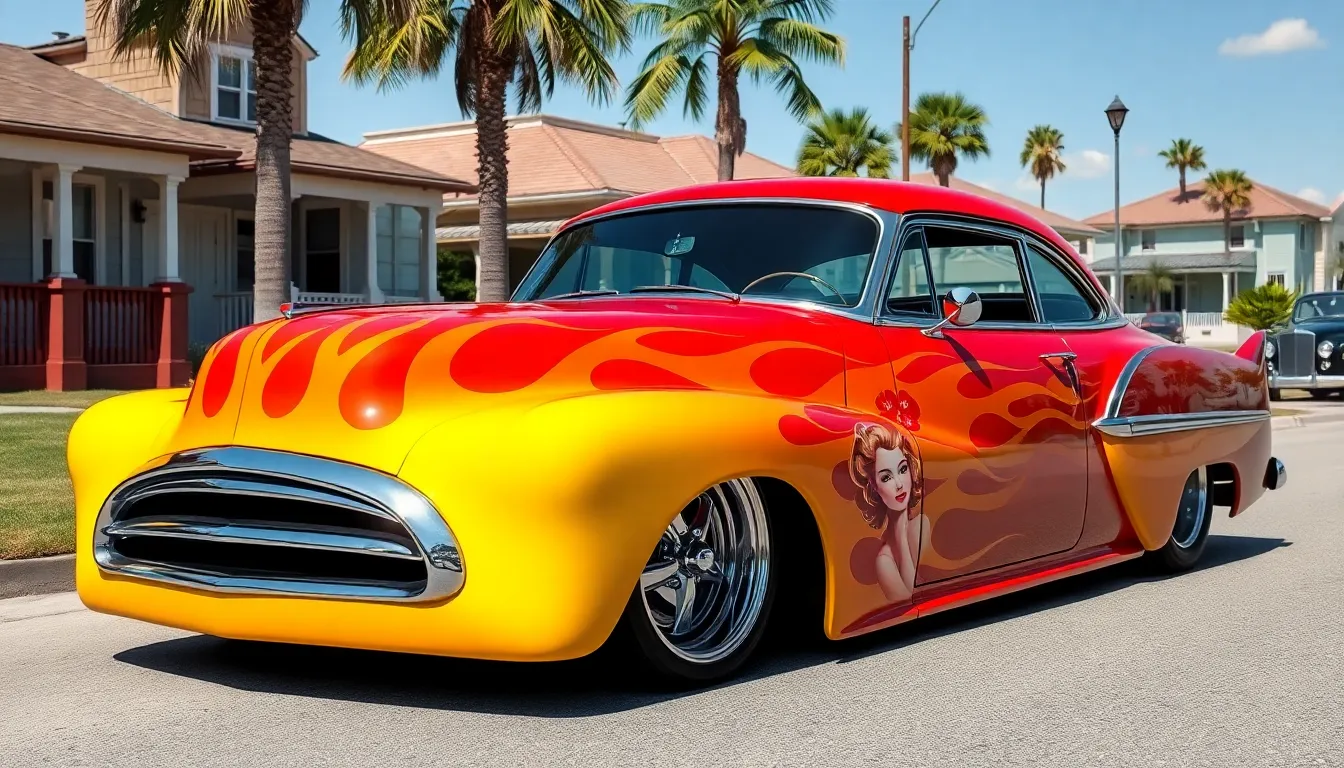
Custom paint work transforms ordinary rockabilly cars into rolling masterpieces that command attention wherever they cruise. These artistic expressions capture the raw energy and rebellious spirit that defines authentic rockabilly culture.
Flame Paint Schemes
Flames represent the quintessential rockabilly paint job that instantly communicates power and attitude. Traditional flame designs start at the front bumper and sweep backward along the hood and fenders in bright oranges, reds, and yellows against glossy black or deep blue basecoats. Hot rod enthusiasts often choose ghost flames using subtle pearl or metallic paints that shimmer under different lighting conditions.
Modern flame techniques include airbrushed gradients that create realistic fire effects with deeper shadows and brighter highlights. Custom painters frequently add pinstriping details around flame edges to enhance definition and create more dramatic visual impact. Popular color combinations feature electric blue flames on silver bases or traditional red and orange flames on midnight black surfaces.
Pin-Up Girl Artwork
Pin-up artwork brings vintage glamour and provocative charm to rockabilly car hoods, doors, and trunk lids. Talented airbrush artists recreate classic 1940s and 1950s pin-up poses featuring beautiful women in period clothing, military uniforms, or playful poses that capture the era’s aesthetic. These detailed portraits often incorporate elements like victory rolls, red lipstick, and vintage swimwear or sailor outfits.
Professional custom painters use multiple paint layers and careful shading techniques to achieve photorealistic results that rival original pin-up illustrations. Many rockabilly car owners commission original artwork inspired by famous pin-up artists like Alberto Vargas or Gil Elvgren. Color palettes typically feature warm skin tones against vibrant backgrounds in blues, reds, or sunset gradients.
Vintage Racing Stripes
Racing stripes deliver bold visual impact while honoring the competitive spirit of 1950s and 1960s motorsports culture. Classic dual stripes run from front to rear along the car’s centerline in contrasting colors like white stripes on red bodies or black stripes on yellow surfaces. Single offset stripes create asymmetrical designs that emphasize the car’s aggressive stance and performance capabilities.
Custom stripe configurations include hash marks, checkerboard patterns, and number panels that reference vintage racing aesthetics. Professional installers use high-quality vinyl materials or hand-painted techniques to ensure clean edges and long-lasting durability. Popular stripe widths range from narrow 2-inch accent lines to bold 12-inch racing stripes that dominate the car’s visual presence.
Essential Engine Modifications for Rockabilly Cars
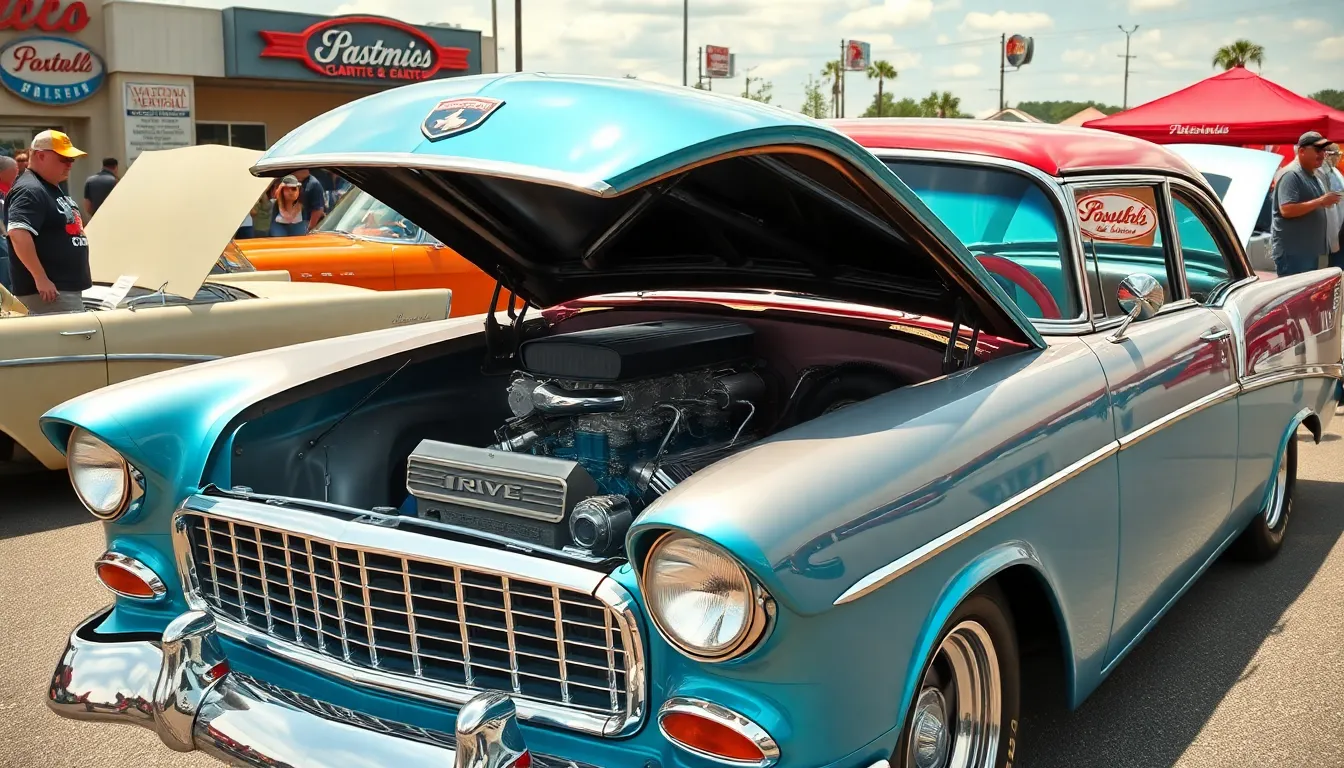
Performance and visual appeal go hand in hand when building the perfect rockabilly machine. These classic modifications transform ordinary engines into powerful statements that capture the rebellious spirit of 1950s hot rod culture.
V8 Engine Swaps
Small block Chevy 350 engines dominate rockabilly builds due to their incredible versatility and abundant aftermarket support. We’ve seen countless builds where enthusiasts drop these powerhouses into early Ford bodies, creating the perfect blend of reliability and performance. The 350’s compact size fits easily into most engine bays while delivering between 250 to 400 horsepower depending on the build specifications.
Ford 302 Windsor motors offer authentic Blue Oval heritage that appeals to purist builders who want to maintain brand loyalty. These engines produce excellent torque characteristics that suit the rockabilly driving style perfectly. Many builders choose 302s when working with classic Ford platforms like the ’32 Roadster or ’40 Coupe to preserve the original manufacturer’s DNA.
Big block installations create the ultimate power statement for serious rockabilly enthusiasts who demand maximum performance. Chevy 454s and Ford 460s generate massive torque figures that transform any car into a tire-smoking beast. Installation requires important modifications to accommodate the larger displacement engines, but the results speak volumes at car shows and cruise nights.
Supercharger Installations
Roots style superchargers provide the classic whine that defines authentic rockabilly engine sounds while delivering instant throttle response. We recommend 6-71 and 8-71 blowers for their period-correct appearance and proven reliability in street applications. These superchargers typically add 100 to 150 horsepower while creating the intimidating visual presence that rockabilly cars demand.
Centrifugal superchargers offer modern efficiency for builders who prioritize maximum power output over vintage aesthetics. ProCharger and Paxton units mount cleanly in most engine bays and provide excellent power gains throughout the RPM range. Installation typically requires custom mounting brackets and upgraded fuel systems to support the additional airflow demands.
Blower manifold selection determines both performance characteristics and visual impact of the supercharger installation. Tunnel ram manifolds create the most aggressive appearance but require hood modifications on most applications. Single plane manifolds offer better street drivability while maintaining the supercharged performance advantage that rockabilly enthusiasts crave.
Chrome Headers and Exhaust Systems
Long tube headers maximize exhaust flow while creating the distinctive visual appeal that defines rockabilly engine bays. Chrome plated steel headers resist corrosion and maintain their mirror finish through countless car show seasons. We’ve found that 1¾-inch primary tubes provide the best balance of performance and sound quality for most street applications.
Lakester exhaust pipes capture the essence of Bonneville Salt Flats racing heritage with their distinctive upswept design. These exhaust systems route pipes along the car’s flanks before exiting behind the rear wheels, creating an unmistakable profile. The configuration works particularly well on roadsters and coupes where ground clearance allows proper pipe routing.
Side pipe installations deliver maximum visual and auditory impact for rockabilly builds that prioritize aggressive styling. Chrome or stainless steel construction ensures long-lasting appearance while providing excellent exhaust note. Proper heat shielding becomes critical to protect both passengers and paintwork from the intense temperatures generated by exposed exhaust components.
Vintage Interior Features That Complete the Look
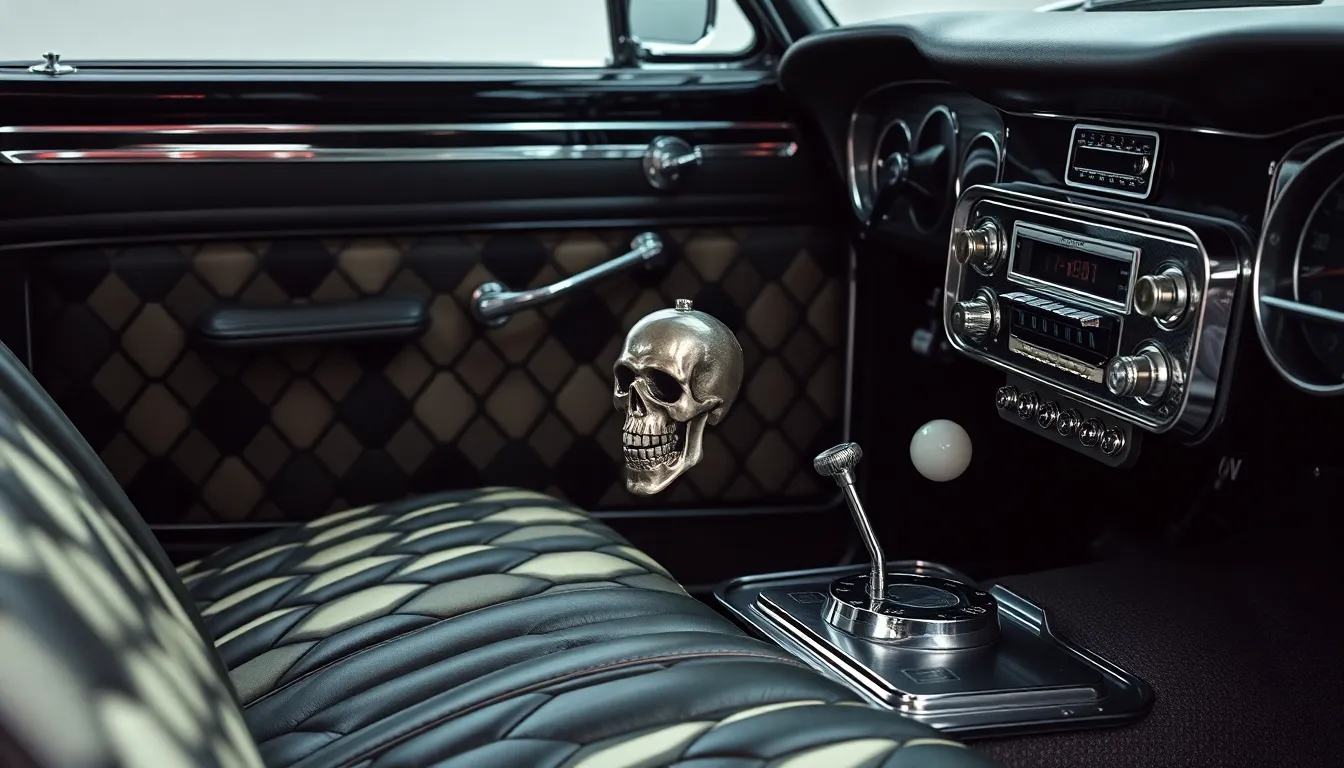
While engine modifications and custom paint jobs capture attention from the outside, authentic rockabilly cars demand period-correct interior details that transport drivers back to the golden age of hot rodding.
Tuck and Roll Upholstery
Tuck and roll upholstery serves as the cornerstone of authentic rockabilly car interiors, featuring diamond-shaped patterns that defined 1950s custom car culture. We typically see this distinctive quilted leather or vinyl covering bench seats, door panels, and dashboard areas in classic rockabilly builds. Popular color combinations include black and white, red and white, or solid black installations that complement exterior paint schemes.
Professional upholsterers create these patterns using specialized techniques that involve hand-stitching individual diamond sections with contrasting piping. The process requires precise measurements and careful attention to tension, ensuring each diamond maintains uniform shape and size. Many rockabilly enthusiasts choose heavy-duty marine grade vinyl for durability, while others prefer genuine leather for premium builds.
Installation costs range from $1,200 to $3,500 depending on coverage area and material quality. Complete interior packages typically include front and rear seats, door panels, and kick panels. Some builders extend the tuck and roll treatment to headliners and package trays for maximum visual impact.
Skull Shifter Knobs
Skull shifter knobs represent the rebellious spirit that drives rockabilly car culture, transforming mundane gear changes into statements of attitude and style. These distinctive accessories typically feature detailed anatomical designs cast in solid metal, resin, or carved bone materials. We find them mounted on manual transmissions, floor shifters, and even column shift applications in period-correct builds.
Quality skull knobs range from $45 to $200 depending on materials and craftsmanship levels. Premium examples feature hand-carved bone construction with intricate detail work, while budget options use cast resin with painted finishes. Many feature threaded inserts that accommodate standard shifter shaft sizes including 3/8-inch and 7/16-inch applications.
Installation requires matching thread pitch and ensuring proper height clearance for smooth shifting operation. Some builders prefer larger skull designs that fill the palm completely, while others choose smaller versions for subtle rockabilly touches. Chrome and brass finished skulls complement polished engine bay components and interior trim pieces.
Vintage Radio Upgrades
Vintage radio upgrades blend classic aesthetics with modern functionality in rockabilly car builds, maintaining period-correct appearance while delivering contemporary sound quality. We recommend reproduction units that feature original 1950s styling with hidden Bluetooth connectivity, USB inputs, and AM/FM capabilities. Popular brands like Custom Autosound and RetroSound manufacture these specialized units for classic car applications.
Installation typically requires custom dash modifications and speaker placement planning to achieve optimal sound distribution. Original radio openings in 1950s cars measure approximately 4 inches by 6 inches, accommodating most reproduction units without major cutting. Modern speakers can be concealed behind original grille cloth or mounted in custom kick panel locations.
Complete vintage radio systems cost between $350 and $800 including speakers and installation hardware. Premium packages include amplifiers, subwoofers, and wireless remote controls hidden from view. Many rockabilly builders choose single DIN units with large analog dials and chrome bezels that complement interior chrome trim and gauge clusters.
Lowrider Modifications for That Perfect Stance
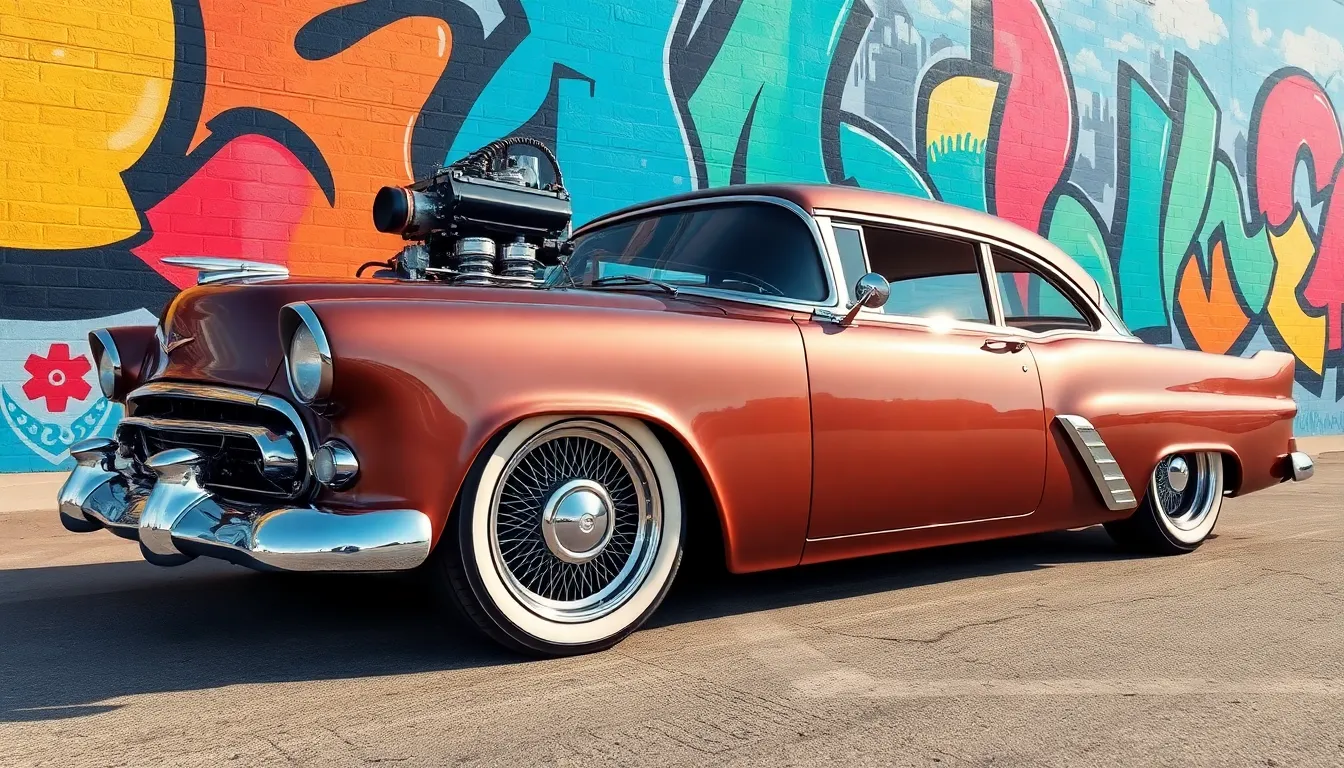
Rockabilly cars demand the perfect stance to achieve that iconic low-slung profile that defines the culture. We’ll explore the suspension modifications that transform these vintage rides into ground-hugging beauties.
Air Bag Suspension Systems
Air bag systems provide the ultimate flexibility for rockabilly enthusiasts who want precise ride height control. We’ve seen countless builds featuring adjustable air springs that replace traditional coil springs, allowing drivers to raise or lower their vehicles with the flip of a switch. Popular brands like Air Lift and Slam Specialties offer complete kits that include air bags, compressors, and management systems specifically designed for classic car applications.
Installation typically involves mounting air bags at all four corners, connecting them to an onboard compressor system, and installing tank storage in the trunk area. Most rockabilly builders prefer 2500-pound capacity bags for the front and 3000-pound bags for the rear to handle the weight distribution of vintage American steel. The electronic management systems allow for individual corner adjustment, giving us the ability to level the car perfectly regardless of load conditions.
Hydraulic Setups
Hydraulic suspension systems represent the gold standard for serious rockabilly lowrider builds. We favor these setups because they provide instant response and the dramatic stance changes that make heads turn at car shows. Traditional hydraulic systems use aircraft-quality pumps, accumulators, and cylinders to lift and lower the vehicle using pressurized hydraulic fluid.
Four-pump systems offer individual wheel control, allowing for three-wheeling demonstrations and precise stance adjustments that air bags simply can’t match. Quality components from manufacturers like CCE Hydraulics and Street Life typically cost between $3,000 and $8,000 for a complete setup, but the investment delivers unmatched performance and reliability.
Professional installation requires reinforcing the frame rails and mounting heavy-duty hydraulic cylinders at each corner. Most rockabilly builds incorporate 8-inch or 10-inch cylinders for maximum lift capability, paired with chrome-plated pumps and tanks that add visual appeal to the engine bay and trunk areas.
Custom Wire Wheels
Wire wheels complete the lowrider aesthetic while providing the perfect complement to a slammed stance. We recommend authentic spoke wheels in classic designs that honor the golden age of American automotive styling. Popular sizes range from 13-inch to 15-inch diameter, with 72-spoke and 100-spoke patterns being the most sought-after configurations.
Quality wire wheels from manufacturers like Zenith and Dayton feature chrome-plated spokes and polished aluminum or chrome-plated steel rims. Pricing typically ranges from $400 to $800 per wheel, depending on size and spoke count. Many rockabilly builders opt for whitewall tires mounted on these wheels to enhance the vintage appearance and create that perfect contrast against custom paint jobs.
Proper maintenance involves regular spoke tensioning and chrome polishing to maintain the mirror-like finish that defines quality wire wheel setups. We’ve found that investing in authentic wire wheels rather than cheaper alternatives pays dividends in both appearance and longevity, ensuring your rockabilly build maintains its stunning visual impact for years to come.
American Graffiti Inspired Rockabilly Builds
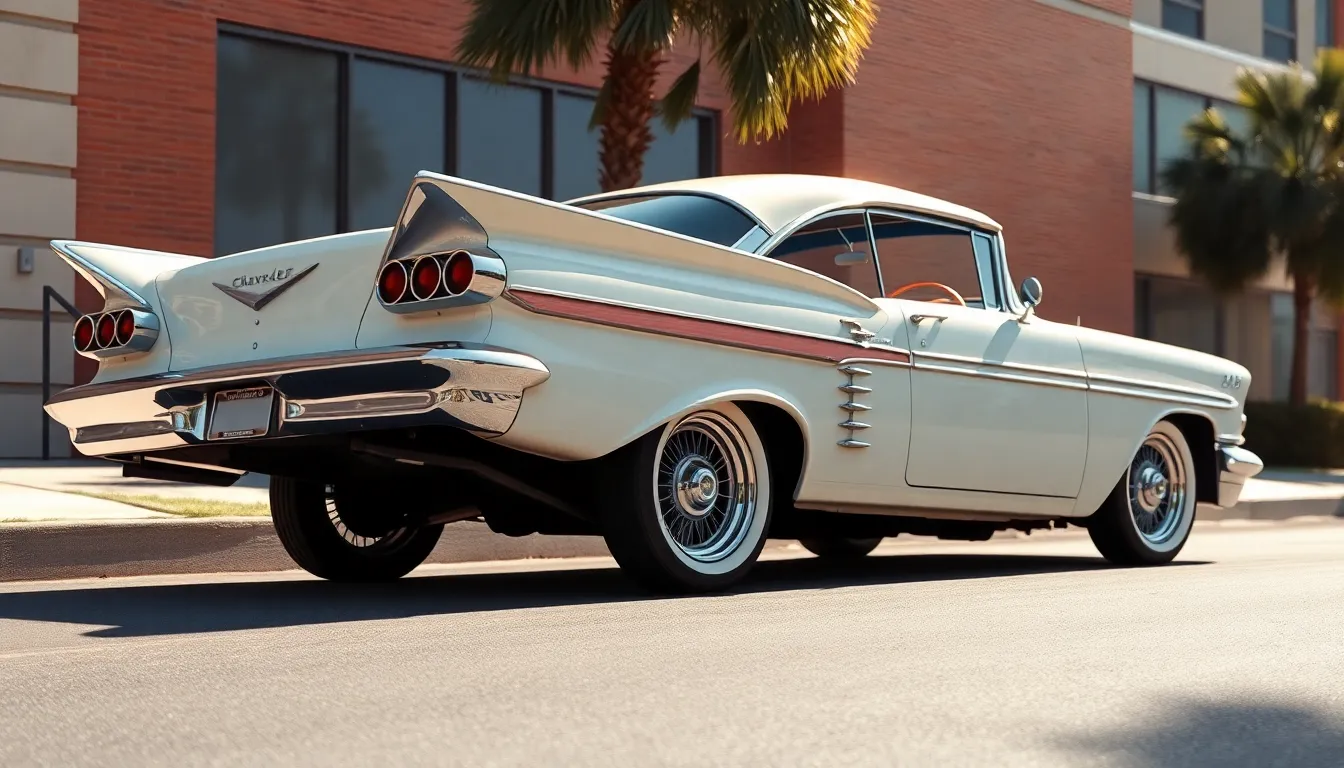
George Lucas’s 1973 masterpiece captured the essence of cruising culture that continues to influence rockabilly builds today. These iconic vehicles from the film showcase the perfect blend of street presence and period authenticity that defines modern rockabilly restorations.
1958 Chevrolet Impala
Sweeping lines and dramatic chrome make the ’58 Impala a standout choice for rockabilly enthusiasts. We see builders focusing on the car’s distinctive triple taillights and sculptured rear quarter panels that epitomize late 1950s styling excess. Continental kits add authentic period flair while maintaining the vehicle’s elegant proportions.
Lowered suspensions transform the Impala’s already impressive stance into something truly commanding. Air bag systems allow for precise ride height adjustments while preserving the factory smooth ride quality. Custom wire wheels with whitewall tires complete the classic cruiser aesthetic that made this model famous in American Graffiti.
Engine modifications typically center around Chevrolet’s small block V8 platform for reliability and parts availability. Builders often install 350 cubic inch motors with period correct intake manifolds and chrome air cleaners. Dual exhaust systems with glasspacks deliver that distinctive rumbling sound that announces the car’s presence from blocks away.
1955 Ford Thunderbird
Ford’s first generation Thunderbird represents the pinnacle of 1950s personal luxury styling. We find these builds emphasizing the car’s removable hardtop and distinctive porthole windows that create an unmistakable silhouette. Two tone paint schemes in classic combinations like red and white or black and yellow enhance the vehicle’s already dramatic proportions.
Performance upgrades focus on Ford’s legendary Y block V8 engine for authentic period power. Builders frequently upgrade to 312 cubic inch motors with three two barrel carburetors for impressive acceleration. Chrome valve covers and air cleaners maintain the engine bay’s show quality appearance while delivering modern reliability.
Interior modifications preserve the Thunderbird’s luxury appointments while adding rockabilly touches. Tuck and roll upholstery in matching exterior colors creates visual continuity throughout the build. Custom steering wheels and skull shifter knobs add rebellious elements without compromising the car’s sophisticated character.
1956 Mercury Montclair
Mercury’s mid level offering provides the perfect foundation for understated rockabilly builds. We appreciate how builders use the Montclair’s clean lines and subtle chrome accents to create elegant street machines. Frenched headlights and custom grilles enhance the car’s distinctive front end styling without overwhelming its factory proportions.
Suspension modifications typically involve mild lowering to improve the car’s already impressive road presence. Dropped spindles and lowering blocks achieve the desired stance while maintaining comfortable ride quality. Custom wheels in 15 or 16 inch diameters provide modern tire options while preserving period appropriate styling.
Mercury’s powerful V8 engines offer excellent performance potential for rockabilly applications. Builders often upgrade to 312 or 368 cubic inch motors with modern ignition systems for reliable operation. Dual exhaust systems with period correct mufflers deliver smooth power delivery and that classic Mercury sound signature.
Budget-Friendly Ways to Build Your First Rockabilly Car
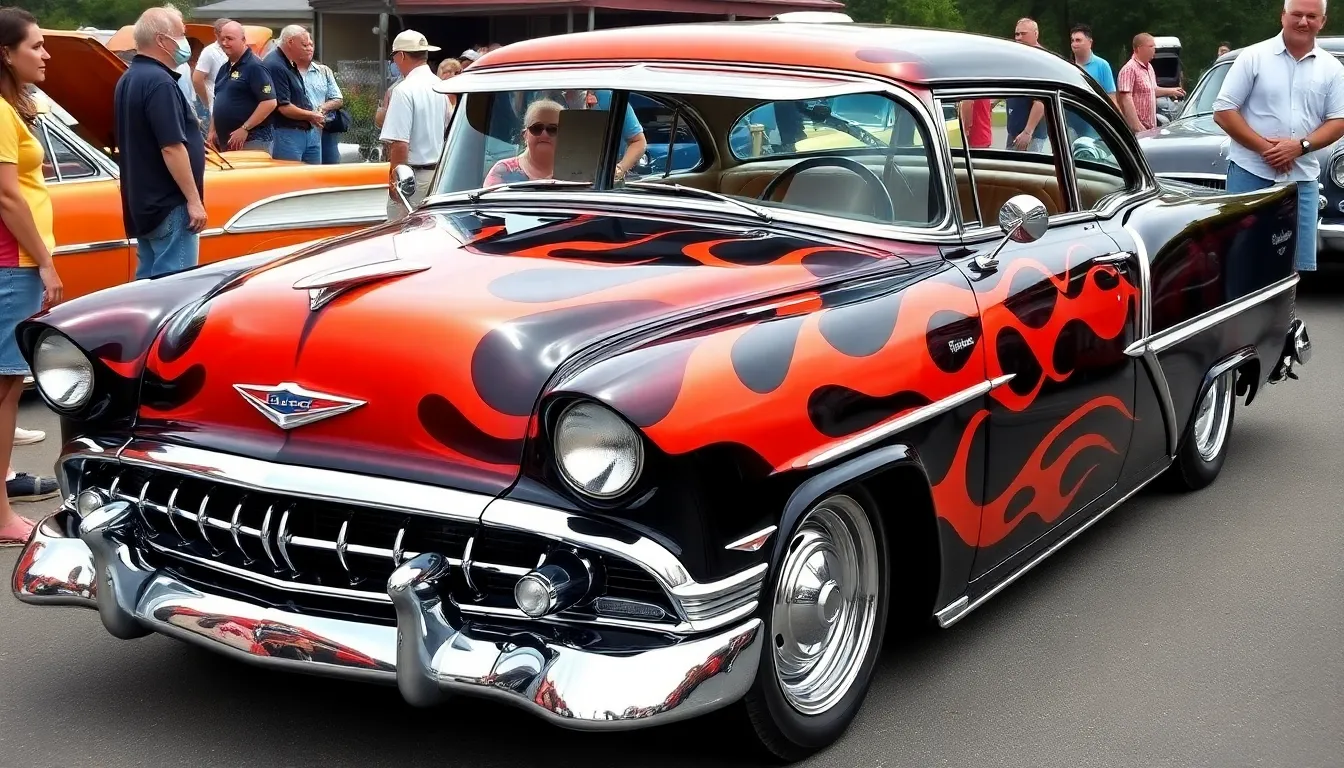
Building your first rockabilly car doesn’t require deep pockets or professional fabrication skills. Smart planning and strategic choices can transform an affordable project into a stunning tribute to 1950s rebellion.
Finding Affordable Project Cars
Explore online marketplaces like Facebook Marketplace and Craigslist where sellers often list project cars between $2,000 and $8,000. Vintage Fords from the late 1940s through 1950s frequently appear at reasonable prices, especially models with surface rust rather than structural damage.
Visit local swap meets and car shows where enthusiasts sell partially completed projects or barn finds. We’ve discovered solid 1949 Ford Coupes and 1953 Chevrolet Bel Airs at these events for under $5,000, often with valuable parts already included.
Consider less popular models that still capture rockabilly essence without premium pricing. Cars like the 1950 Mercury Eight or 1954 Ford Customline offer authentic styling at half the cost of their more famous counterparts.
Target cars with good bones rather than perfect paint or chrome. A vehicle with solid frame rails and minimal rust will serve as a better foundation than a pretty car with hidden structural issues.
DIY Modification Tips
Start with suspension modifications that deliver maximum visual impact for minimal cost. Installing lowering springs costs around $200 compared to $2,000 for air bag systems, yet still achieves that essential rockabilly stance.
Learn basic bodywork techniques using YouTube tutorials and practice on scrap metal first. We recommend starting with simple dent repair and primer work before attempting complex modifications like chopped tops or fender work.
Focus on bolt on performance upgrades rather than internal engine modifications. Headers, intake manifolds, and carburetor swaps provide noticeable power gains without requiring machine shop services or specialized tools.
Master spray can painting techniques for smaller components like valve covers, air cleaners, and interior trim pieces. Quality automotive spray paint costs $15 per can versus $500 for professional powder coating services.
Cost-Effective Styling Options
Create flame paint schemes using masking tape and rattle cans for under $100. Traditional orange and yellow flames over black base coats capture authentic rockabilly style without custom painter expenses.
Install reproduction chrome accessories from companies like Speedway Motors and Summit Racing. Chrome valve covers, air cleaners, and bumper guards add period correct details for $50 to $150 per piece.
Source vintage interior pieces from salvage yards and online forums where enthusiasts sell spare parts. Tuck and roll seat covers cost $300 to install yourself compared to $1,500 for professional upholstery work.
Add period correct wheels like steel rims with baby moon hub caps or basic wire wheels. These options start at $400 for a complete set versus $2,000 for custom billet wheels, yet maintain authentic rockabilly appearance.
Famous Rockabilly Cars From Movies and TV Shows
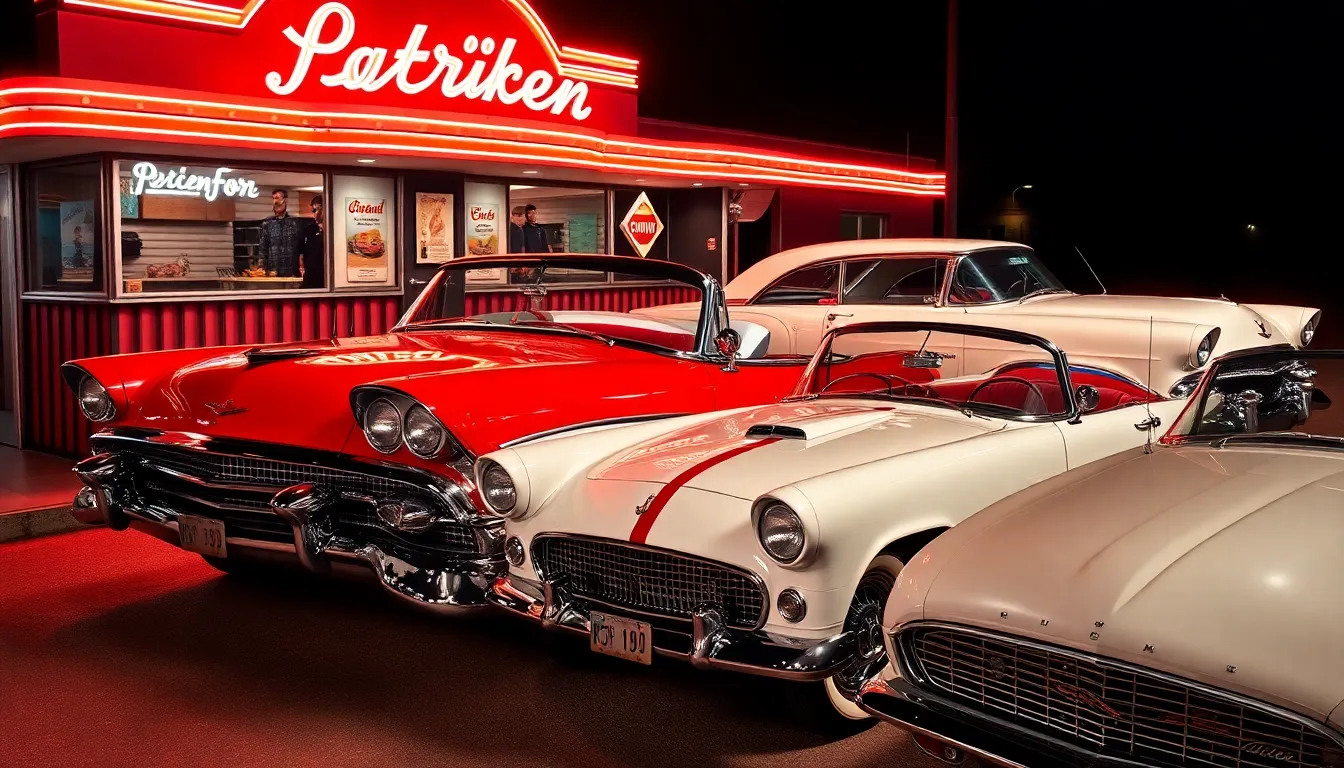
Hollywood has immortalized the most iconic rockabilly cars through memorable film and television appearances. These legendary vehicles continue to inspire modern hot rod builds decades after their screen debuts.
Christine’s 1958 Plymouth Fury
Christine’s 1958 Plymouth Fury stands as one of cinema’s most terrifying automotive characters in Stephen King’s supernatural thriller. We witness the car’s malevolent personality through its pristine red and white paint scheme, complete with factory chrome bumpers and distinctive tailfins that define late 1950s styling. The Fury featured Plymouth’s powerful 318 cubic inch V8 engine, producing 225 horsepower that made it a formidable performer on screen.
Directors chose the 1958 Plymouth Fury for its imposing presence and aggressive front grille design that perfectly conveyed the car’s sinister nature. We see multiple examples throughout the film, as production teams used over 20 different Plymouth Furys to achieve the dramatic transformation sequences. The car’s automatic transmission and push button shifter represented cutting edge technology for its era, while the two tone interior with red vinyl seats created an authentic period atmosphere.
Modern rockabilly enthusiasts often recreate Christine’s exact specifications, including the factory radio delete option and manual steering that were common in base model builds. We find that collectors specifically seek 1958 Plymouth Furys with the distinctive chrome side spears and dual exhaust systems that appeared in the film. The movie’s influence on rockabilly culture remains strong, with many builders incorporating Christine’s red and white color combination into their own custom projects.
Grease Lightning’s 1948 Ford De Luxe
Grease Lightning’s 1948 Ford De Luxe transformed from a rusty project car into a stunning hot rod showcase in the beloved musical. We watch Danny Zuko and the T Birds convert their rough barn find into a gleaming white convertible with red racing stripes and custom flame graphics. The De Luxe featured Ford’s reliable 239 cubic inch flathead V8 engine, which provided adequate power for both street cruising and the film’s dramatic racing sequences.
Production crews modified the original 1948 Ford with period correct accessories, including dual spotlights, fender skirts, and whitewall tires that captured authentic 1950s styling. We observe how the movie’s transformation sequence showcases classic hot rodding techniques like engine swaps, custom upholstery, and chrome exhaust systems. The car’s chopped windshield and lowered stance demonstrate fundamental rockabilly modifications that enthusiasts still use today.
Hollywood magic created multiple versions of Grease Lightning for different filming requirements, with stunt cars, beauty shots, and mechanical doubles serving exact production needs. We appreciate how the film’s technical crew achieved the car’s pristine final appearance using custom paint work, polished chrome, and tuck and roll interior that exemplify rockabilly craftsmanship. The 1948 Ford De Luxe continues inspiring modern builders who recreate the exact specifications from the movie, including the distinctive side exhaust pipes and custom steering wheel that appeared on screen.
Happy Days’ 1956 Ford Thunderbird
Happy Days’ 1956 Ford Thunderbird represents the pinnacle of 1950s automotive sophistication in television’s longest running period sitcom. We follow the Fonz’s adventures with his pristine T Bird, featuring the car’s signature porthole windows, continental kit spare tire, and removable hardtop that defined personal luxury vehicles of the era. The Thunderbird’s 312 cubic inch V8 engine produced 225 horsepower, making it both stylish and performance oriented for television’s coolest character.
Television producers selected the 1956 Thunderbird for its iconic status and instant recognition among viewers who associated the car with rebellion and style. We notice how the show’s creators used the car’s distinctive wire wheels, dual exhaust, and chrome details to reinforce the Fonz’s tough guy image throughout multiple seasons. The T Bird’s two seater configuration and sporty handling characteristics made it perfect for the character’s independent personality and frequent solo adventures.
Behind the scenes production utilized several different 1956 Thunderbirds to maintain continuity across multiple filming seasons and various storylines. We see how the show’s attention to period details includes authentic accessories like the optional hardtop boot, fender mounted mirrors, and factory radio that appeared in original Thunderbird advertisements. Modern rockabilly builders often reference Happy Days when creating their own T Bird tributes, incorporating the show’s exact color combinations and styling cues that became synonymous with 1950s cool factor.
Car Shows and Events for Rockabilly Enthusiasts

Immersing ourselves in the vibrant community of rockabilly car enthusiasts requires attending the right events where these rolling pieces of art truly shine. These gatherings celebrate the intersection of vintage automotive culture and rebellious 1950s spirit that we’ve explored throughout our journey.
Viva Las Vegas Rockabilly Weekend
Vegas transforms into a time machine each April when the industry’s largest rockabilly festival takes over the Orleans Hotel and Casino for four days of pure automotive nostalgia. We witness over 15,000 attendees from across the globe bringing their finest rides to compete in multiple car show categories including Best Hot Rod, Best Kustom, and Best Rockabilly Paint Job.
Participants showcase everything from flame painted 1932 Ford Roadsters to hydraulic equipped lowriders with tuck and roll interiors. The event features more than 200 vintage automobiles parked throughout the hotel grounds, creating an outdoor museum of rockabilly culture. Live performances by legendary rockabilly bands provide the perfect soundtrack while we admire skull shifter knobs, chrome headers, and pin up girl artwork adorning these mechanical masterpieces.
Registration typically opens in January with car show entry fees ranging from $45 to $65, making it accessible for enthusiasts working within budget constraints. Winners receive custom trophies and bragging rights that last throughout the rockabilly community for years.
Hot Rod Magazine Power Tour
Spanning seven cities over one week each June, the Hot Rod Power Tour represents the ultimate road trip for rockabilly car owners seeking to test their builds across hundreds of miles. This moving festival attracts over 5,000 participants annually who cruise together from city to city, stopping at major venues and racetracks along predetermined routes.
Power Tour participants often drive the same vehicles featured in our previous discussions about muscle cars and classic hot rods. We see 1969 Dodge Charger R/Ts with 440 Magnum engines cruising alongside 1957 Chevrolet Bel Airs sporting modern air bag suspension systems. The event costs $99 for the full tour registration, which includes access to all venues, official event shirts, and the coveted Long Hauler jacket for completing the entire journey.
Each stop features vendor midways where we can source vintage radio upgrades, custom wire wheels, and reproduction chrome accessories. Tech seminars cover topics like supercharger installations and hydraulic setup maintenance, providing valuable education for DIY enthusiasts building rockabilly cars on tight budgets.
Goodguys Rod and Custom Shows
Operating 21 events annually across the United States, Goodguys represents the gold standard for organized hot rod and custom car exhibitions. Their shows welcome vehicles manufactured through 1987, making them perfect venues for displaying rockabilly inspired builds ranging from traditional 1940 Ford Coupes to modified 1970 Plymouth ‘Cudas.
We find over 3,000 vehicles at their largest events like the Spring and Fall Nationals, where rockabilly cars compete in specialized classes including Street Rod, Custom, and Muscle Car divisions. Entry fees typically range from $35 to $50 per vehicle, with additional costs for premium parking spaces closest to main vendor areas.
Goodguys events feature extensive swap meets where we can locate hard to find parts for engine modifications and lowrider components. Their Autocross competition allows rockabilly car owners to test performance upgrades like small block Chevy 350 swaps and centrifugal supercharger installations in a controlled environment. Awards ceremonies recognize outstanding craftsmanship in categories that celebrate the custom paint jobs, period correct interiors, and authentic styling elements that define our rockabilly automotive culture.
Conclusion
Rockabilly cars represent far more than mere transportation – they’re rolling testaments to American ingenuity and rebellious spirit. These iconic vehicles continue capturing hearts across generations because they embody authenticity in an increasingly digital industry.
Whether you’re drawn to flame-painted hot rods or chrome-laden classics from Hollywood’s golden age we’ve shown that entering this vibrant community doesn’t require unlimited resources. The rockabilly car scene thrives on creativity passion and the shared love of preserving automotive history.
From budget builds to show-stopping masterpieces every rockabilly car tells a unique story. As you consider joining this timeless culture remember that it’s not about perfection – it’s about celebrating the raw energy and craftsmanship that defined an entire generation’s automotive dreams.
Frequently Asked Questions
What defines a rockabilly car?
Rockabilly cars are vintage automobiles from the 1950s era that embody rebellion and style. They feature distinctive modifications like lowered suspensions, custom paint jobs (especially flames), chrome details, and powerful V8 engines. These cars reflect the youthful defiance and cultural spirit of the 1950s rockabilly music scene, combining vintage aesthetics with performance upgrades.
Which classic cars are most popular in rockabilly culture?
The most iconic rockabilly cars include the 1932 Ford Roadster with its chopped windshield and small block V8, the 1940 Ford Coupe known for elegant lines and aggressive stance, and the 1957 Chevrolet Bel Air featuring chrome details and tailfins. These models perfectly capture the rebellious spirit and distinctive styling of the rockabilly era.
What are popular engine modifications for rockabilly cars?
Popular engine swaps include small block Chevy 350 and Ford 302 Windsor motors for reliability, or big block options like Chevy 454s and Ford 460s for serious power. Many builders also add superchargers (roots style or centrifugal) and chrome headers with custom exhaust systems to enhance both performance and the distinctive rockabilly sound.
What paint designs are typical for rockabilly cars?
Classic rockabilly paint schemes include vibrant flame patterns in bright colors, pin-up girl artwork for vintage glamour, and vintage racing stripes that pay homage to 1950s-60s motorsports. These custom paint jobs transform vehicles into rolling masterpieces that embody the culture’s raw energy and rebellious spirit, making each car a unique artistic expression.
How can I build a rockabilly car on a budget?
Start by finding affordable project cars at online marketplaces and swap meets, focusing on vintage Fords from the late 1940s-1950s. Use DIY modifications like cost-effective suspension upgrades, basic bodywork techniques, and bolt-on performance parts. Budget-friendly styling options include flame paint schemes and reproduction chrome accessories to achieve an authentic look affordably.
What interior features complete the rockabilly aesthetic?
Essential rockabilly interior elements include tuck and roll upholstery with diamond-shaped patterns, skull shifter knobs that embody the rebellious spirit, and vintage radio upgrades that blend classic looks with modern functionality. These period-correct details enhance the authentic experience and transport drivers back to the golden age of hot rodding.
What suspension modifications achieve the classic rockabilly stance?
Rockabilly cars typically use air bag suspension systems for precise ride height control or hydraulic setups for instant response and dramatic stance changes. These modifications are often paired with custom wire wheels featuring authentic spoke designs that enhance the vintage aesthetic while providing the low, aggressive stance that defines rockabilly style.
Which movies and TV shows feature famous rockabilly cars?
Notable rockabilly cars in entertainment include Christine’s sinister 1958 Plymouth Fury from Stephen King’s thriller, Grease Lightning’s transformed 1948 Ford De Luxe from “Grease,” and the sophisticated 1956 Ford Thunderbird from “Happy Days.” These Hollywood vehicles have significantly influenced modern rockabilly builds and helped immortalize the culture in popular media.
Where can rockabilly car enthusiasts connect and showcase their vehicles?
Major events include Viva Las Vegas Rockabilly Weekend with thousands of attendees, the Hot Rod Magazine Power Tour featuring week-long road trips, and Goodguys Rod and Custom Shows with competitions and swap meets. These gatherings celebrate the artistry of rockabilly vehicles while fostering strong community bonds among enthusiasts nationwide.

